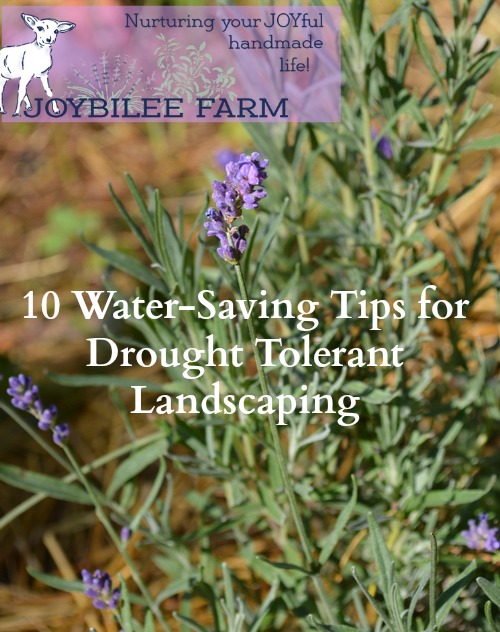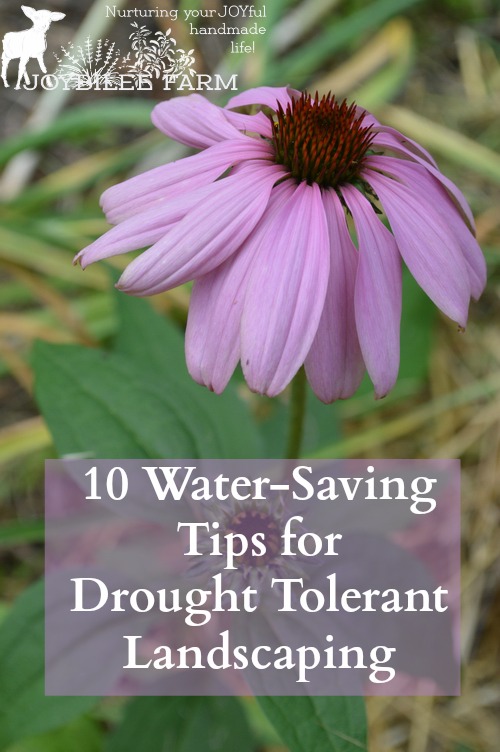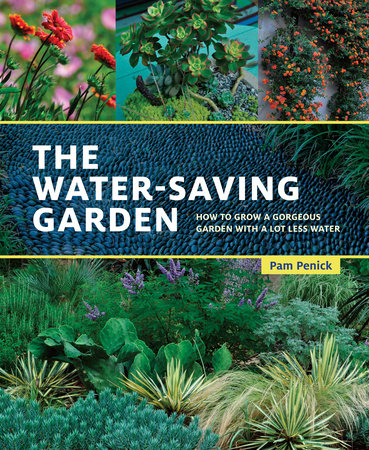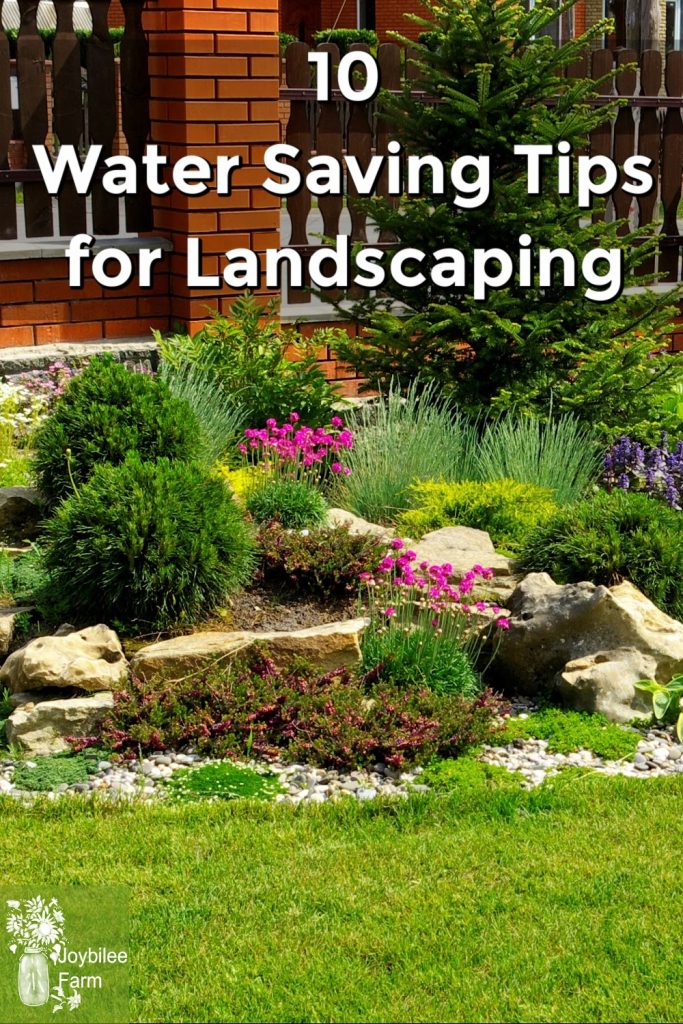10 Water-Saving Tips for your Drought Tolerant Landscaping
You don’t have to give up on a gorgeous yard in drought. You can use the drought tolerant landscaping principles in this book to create a beautiful and productive yard. Here are 10 water-saving tips for landscaping.
Water is a precious resource. With too little water your garden may wither and die. With too much water, your plants will rot from the roots up. Balancing the water needs of plants with the variable water in your landscape is an art. When you don’t get enough water you need drought tolerant landscaping for your garden to thrive, especially with the variable weather patterns we’ve been seeing in the last decade.
The Water-Saving Garden, How to grow a gorgeous garden with a lot less water, by Pam Penick (10 Speed Press: Berkley, 2016) is filled with tips to help you create a gorgeous drought tolerant garden with the water you have.
You don’t have to give up on a gorgeous yard in drought. You can use the drought tolerant landscaping principles in this book to create a beautiful and productive yard. The book is divided into 5 parts. The first 4 offer tips for creating a beautiful, attractive landscape despite a lack of water for gardening. The final section lists 101 plants to use in a water-saving garden. However, of the 101 plants listed, less than 20% are rated for zone 3.
Come back on Monday and see my list of 20 plants for your water-saving zone 3 or higher garden. I’ve adapted Penick’s list and added a few of my own favourites to help you create that landscape in your dreams while making do with the rainfall that you have. See my list of water-saving plants for your zone 3 or higher landscape here (coming next Monday).
About Pam Penick
Pam Penick is a garden designer from Austin, Texas. She’s also an award-winning blogger and a contributor to Fine Gardening, Organic Life, and Garden Design. The Water-Saving Garden is Pam’s second book. You can meet Pam on her blog, Digging, Cool gardens in a hot climate.
Since the author is a professional landscape designer the book is filled with professional landscape designs. You won’t find the English country garden or raised bed vegetable garden on these pages. While the principles of drought-tolerant gardening can be utilized with your vegetable garden, to some extent, there are no recommendations for fruit trees, perennial vegetables, or culinary herbs in its pages. The book is aimed at the ornamental landscape. Take the tips in this book and use them alongside Angela England’s Gardening Like a Ninja to glean the concepts you need to excel with an edible but water-saving landscape.
Nice pictures of professionally designed landscapes
The photography is lovely with professionally designed landscapes shown at their best season. There are no step-by-step tutorials to show the novice homeowner how to create any of the landscapes in the book. But the book is strong on the principles of water-efficient gardening. If you need step-by-step illustrated tutorials to create your ideal garden, this isn’t the book that will help you do that. If you have enough gardening experience that you can move from principles to specifics, you’ll be inspired by this book.
10 Tips for water-saving gardening
from the book, The Water-Saving Garden by Pam Penick.
Water-Saving Tip #1 Re-direct the water where you want it.
Save the water that does come into your landscape and channel it so that it soaks in slowly.
Change landscape features by adding swales, terracing slopes, and creating rain gardens to capture the water and channel it where plants need it most. This makes the most efficient use of the water you already have.
If you notice after a rainfall, erosion forming deep rivulets in your driveway, pathways, or hillsides, you need to capture that water. Rivulets are a symptom that the rain is moving too quickly over the landscape. By building swales that cut across the water at right angles, you’ll slow the water down and channel it where your plants can use it best.
Water-Saving Tip #2 Catch and save the water you do get
Adding gutters to direct the rainfall and capturing and holding water in rain barrels or cisterns saves the water when it falls, and holds it for use when you need it to water vegetables and fruit, later. 1 inch of rain falling on 1,000 square feet of roof space yields 600 gallons of water. Estimate the size of the catchment that you need based on the annual rainfall you get in your region. You won’t hold a year’s supply of rain at one time. But you won’t need a 20,000-gallon cistern if your annual rainfall is only 15 inches a year.
Water-Saving Tip #3 Create a rain garden
It may seem counterintuitive, but even in dry garden areas, seasonal rains can wash out an area while seasonal drought makes gardening difficult. A rain garden allows water runoff to enter a garden area through a cut in the sidewalk or curb, diverting water from storm sewers, while it directs the water where you want it. Rain gardens need to be lower than the surrounding area, as water will flow where gravity takes it. By creating the rain garden in a basin shape, with gently sloping sides, water that enters the garden at the high point will naturally move to the lowest point. Rain gardens are planted with grasses and perennial flowers that can absorb excess water, while at the same time, once established will do well in drought.
Since runoff can also be mixed with chemical toxins from streets, don’t plant food crops in a rain garden, that receives runoff that may be contaminated. Instead, use the area for butterfly and pollinator plants. These will attract beneficial insects that will increase fruit and vegetable yields in the long run. Ornamental flowers, like yarrow and coneflower, and grasses also do well in the rain garden area.

Water-Saving Tip #4 Utilize greywater and air-conditioning condensate
Water that drains out of your shower, bath, washing machine, bathroom sink, and de-humidifier can go into the garden instead of into the septic system or municipal sewer system, potentially supplying much of your irrigation needs. It’s called grey water because it is potentially dirty water containing soap, detergent, and dirt. Your plants don’t mind. If you plan to use your greywater use nontoxic, low sodium soap and detergent to avoid harmful build-up in your soil.
Greywater doesn’t usually include water from the dishwasher or kitchen sink that could potentially contain food particles or grease. Nor does it contain water from the toilet or water used to wash diapers. This water needs to go through the proper sanitation procedures. Greywater systems may not be legal in some places. Check with your health department for regulations in your area.

Water-Saving Tip #5 Use native plants that are already adapted to your regional climate conditions
These will be drought tolerant. Many native species have cultivars that have been selected for their showy flowers or leaf colours. Using selected cultivars of native species that are already adapted to your growing conditions can improve the aesthetics of your garden. These are also the plants that your native pollinators are attracted to.
Water-Saving Tip #6 Get rid of the thirsty lawn and plant perennial ground covers and shrubs in their place
Instead of planting turf grass which is a fast-growing nutrient and water guzzler, plant native grasses and drought tolerant grasses or perennial flowers and shrubs that are more water-efficient. The bonus is you won’t have to mow. Native grasses can be allowed to go to seed. When touched with frost they change colour. Sedges and oat grass are drought tolerant with attractive plumes and fall colours.
Water-Saving Tip #7 Use drip irrigation instead of overhead sprinklers to make the water you do use go where plants need it most
Drip irrigation puts the water at the root zone, right where plants need it most. Overhead irrigation can increase the water on the leaves and encourage powdery mildew and other fungal diseases. Drip irrigation not only uses water more efficiently but also keeps leaves dry.
Water-Saving Tip #8 Use paving stones, and mulch to define the paths of your garden and don’t water the paths
Creating permanent paths reduces the amount of water required in the landscape and defines the traffic areas. However, as you are planning where your paths should go, consider the flow of water over the landscape so that your paths don’t become rivers in the rain. Paths should follow a ridgeline rather than a valley, so they stay dry and allow water to pour to the side where your plants are planted.
Water-Saving Tip #9 Do use water features in your garden to create a sense of abundance
Water features like small ponds, barrel ponds, or even birdbaths, offer a sense of coolness while attracting wildlife to the garden. Use a solar-powered pump to prime a fountain or faucet and recirculate water within a closed system. Koi fish and water plants, on a small scale, can evoke a sense of abundance, even with water scarcity. A water feature need not be large to have an impact.

Water-Saving Tip #10 Use plants and hardscape objects to evoke a feeling of water where there is none
Grasses with airy seed heads, waving in the breeze imitate the movement of water. Cascading tree forms remind us of water. A mirror placed within the landscape can imitate a pond surface. Even in the summer drought, plants can create a sense of coolness, when chosen with this in mind.
But I wanted to grow food!
The Water-Saving Gardens focused on the ornamental landscape rather than food growing, but the principles of landscape design used in the book can transfer to your food gardening efforts as well. Conserving water, watering at the root zone, changing landscape features to channel water where it’s most needed should be incorporated into your food gardening efforts, with one exception. Rain gardens that utilize road runoff should not be planted with food crops, due to the potential for contamination. Use these spaces to attract pollinators, which will improve your food crop yields.
If you’ve never thought about water conservation before, this is the time to incorporate these water-saving principles into your plan. Metered city water is only going to get more expensive. Drought and unusual weather systems threaten the stability of the food supply. But the principles expressed in The Water-Saving Garden can make a difference even if you prefer vegetable gardening to landscape design.
Get The Water-Saving Garden, how to grow a gorgeous garden with a lot less water.

Disclaimer: I received a review copy of this book from Blogging For Books. This review represents my honest opinion of this book. This post contains affiliate links.





Absolutely loved this article! So informative and I will be using a lot of these water saving tips. I’ll definitely recommend this well written article to anyone working on their landscaping next spring.
I love how you said that plants can create a sense of coolness when there is a summer drought. My wife and I love to garden and we are preparing for one of the hottest summers ever in our area. I’ll be sure to tell my wife that we should add more plants this summer to our landscaping works to create a feeling of water.